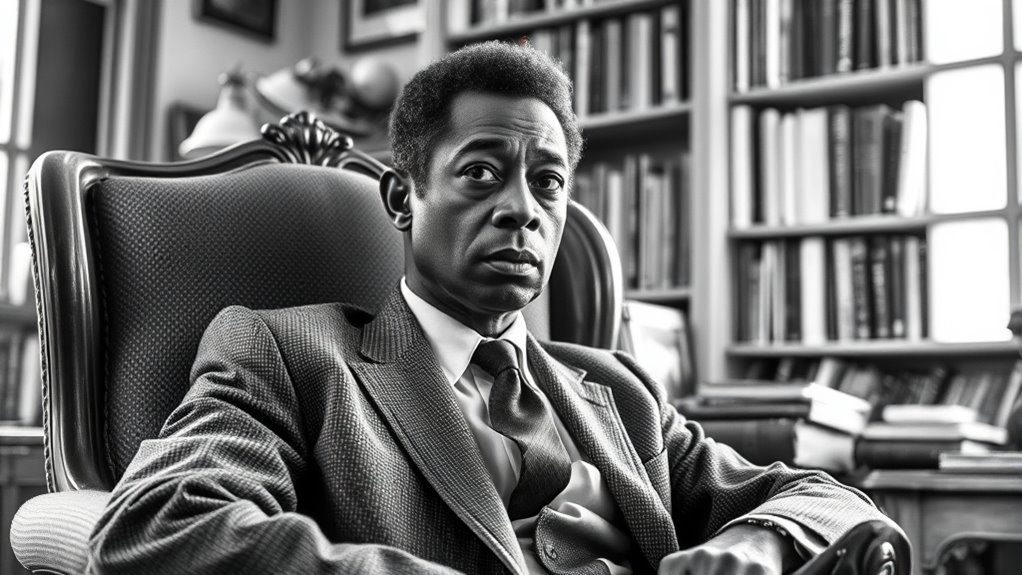James Baldwin was a powerful novelist and activist who challenged America’s racial, social, and sexual boundaries. Through works like *Go Tell It on the Mountain*, *Giovanni’s Room*, and *The Fire Next Time*, he explored identity, love, and injustice, inspiring social change. Baldwin also played a key role in the Civil Rights Movement and built strong relationships with leaders like Martin Luther King Jr. Keep exploring how Baldwin’s impact continues to influence today’s struggles for equality and justice.
Key Takeaways
- James Baldwin was a groundbreaking novelist and essayist known for exploring race, sexuality, and social justice.
- His major works include *Go Tell It on the Mountain*, *Giovanni’s Room*, and *The Fire Next Time*.
- Baldwin actively participated in the Civil Rights Movement, engaging with leaders like Martin Luther King Jr. and Malcolm X.
- His writings challenged systemic racism, advocating for racial equality and human rights through social critique and personal narratives.
- Baldwin’s influence extends beyond literature, shaping discussions on race, identity, and LGBTQ+ issues in America and globally.
Early Life and Influences

James Baldwin was born on August 2, 1924, in Harlem, New York City, into a family marked by poverty and hardship. As the eldest of nine children, you grow up in a household dominated by strict religious discipline, especially under your stepfather, David Baldwin. With limited resources, you take on caregiving roles, supporting your mother and siblings, which shapes your understanding of love, responsibility, and pain. Your early years are colored by domestic tensions and the influence of Pentecostal religion, which you briefly embrace to cope with your identity and confusion about sexuality. You find refuge in libraries and writing, using these outlets to escape your circumstances. The death of your stepfather on the day your youngest sibling is born leaves a lasting emotional impact.
Literary Beginnings and Major Works

You’ll see that Baldwin’s early literary contributions include his powerful first novel, *Go Tell It on the Mountain*, which explores religious and racial identity in Harlem. His major works, like *Giovanni’s Room* and *Another Country*, challenge societal norms around sexuality and race through honest storytelling. These novels and essays set the foundation for his influence as a writer and activist.
Early Literary Contributions
Emerging from a challenging early environment, Baldwin quickly established himself as an incisive voice addressing social issues through his writings. After high school, you begin self-study and apprenticeship in Greenwich Village, working low-paying jobs to support your family and writing ambitions. Early in your career, you publish essays and reviews in respected magazines like *Commentary*, *The Nation*, and *Partisan Review*. Influenced by Richard Wright, you secure fellowships that help fund your work. Your 1948 essay, “The Harlem Ghetto,” gains recognition for addressing racial and socio-economic struggles. Moving to Paris in 1948 provides a freer creative environment, enriching your perspective on race and identity. These early works blend personal experience with social critique, laying the groundwork for your emerging reputation as a courageous and insightful writer. His experiences with discrimination and hardship also informed his understanding of racial injustice and fueled his dedication to activism and literature.
Major Novels and Essays
Baldwin’s major novels mark pivotal moments in American literature, showcasing his mastery of lyrical prose and psychological depth. *Go Tell It on the Mountain* (1953) explores identity, family, and religion in Harlem during the Depression. *Giovanni’s Room* (1956), set in Paris, boldly addresses sexuality and societal norms. *Another Country* (1962) examines interracial relationships and diverse sexual identities, reflecting post-war social shifts. *Tell Me How Long the Train’s Been Gone* (1968) focuses on a famous actor’s reflections on identity, while *If Beale Street Could Talk* (1974) tackles racial injustice through a poignant love story. Baldwin’s works often explore themes of belonging, sexuality, racial tension, family, and societal expectations, capturing the cultural shifts of his era with poetic prose and deep insight. His influence helped to shape American cultural and social discourse, making his novels essential for understanding the complexities of race, identity, and society.
Exploring Race and Identity in Baldwin’s Literature

You see how Baldwin’s stories reveal the complex ways race shapes identity, both personally and socially. He shows that racial identity isn’t just about skin color but involves deep psychological and spiritual struggles. His work also explores how sexuality intersects with race, adding layers to understanding individual and collective identities. Additionally, Baldwin emphasizes the importance of color accuracy in representing these nuanced themes with authenticity and depth.
Racial Identity in Novels
How do Baldwin’s novels reveal the complex ways race shapes individual and collective identities? Baldwin explores race as a systemic force that forces Black Americans to navigate their selfhood within oppressive structures. His characters challenge racial, sexual, and class boundaries, revealing a journey of resistance and self-discovery. Baldwin questions the moral bankruptcy of both Black and white communities, emphasizing shared struggles. He depicts internalized racism as a damaging result of societal devaluation, showing characters wrestling with negative self-images. The past, especially slavery and segregation, shapes their choices and sense of belonging. Baldwin’s literature insists that identity isn’t static; it’s a personal, ongoing negotiation, influenced by history, trauma, and societal expectations. Additionally, Baldwin’s approach to ethical hacking as a metaphor underscores the importance of uncovering hidden vulnerabilities within societal systems to foster true understanding and change.
Personal Narratives and Race
Personal narratives serve as powerful tools in Baldwin’s literature for revealing the intricate ways race influences individual identity. You see how he exposes racism as a psychological and spiritual injury affecting both the oppressed and oppressors. Baldwin’s stories, like “Notes of a Native Son” and “The Fire Next Time,” show how prejudice distorts American ideals and creates a spiritual crisis, especially for white Americans struggling with myths about the nation’s founding. You recognize that Baldwin emphasizes the importance of individual identity, not collective labels, echoing later critical race theory ideas. His reflections highlight shared oppression across racial lines, exposing the intertwined struggles of poor whites and Blacks. Baldwin’s personal encounters abroad reveal how racial identity is shaped by social context and history, illustrating the complex, global nature of race and selfhood. Furthermore, Baldwin’s exploration of self-awareness underscores the necessity of understanding one’s own biases and societal influences to foster genuine empathy and change.
Intersection of Sexuality and Race
What happens when the boundaries of race and sexuality collide in Baldwin’s writing? You see a powerful challenge to societal norms that tightly bind Black identity and queer sexuality. Baldwin explores how racial oppression and sexual identity intertwine, creating layers of alienation and struggle. His characters often face dual marginalization—being both Black and queer—highlighting the violence of rigid binaries. Baldwin critiques the invisibility of Black queer lives within broader civil rights discourse, insisting that sexuality is inseparable from race in understanding identity. His work pushes you to see beyond stereotypes, emphasizing self-definition and spiritual agency. Baldwin’s narratives reveal that embracing both race and sexuality can be a radical act of resistance, expanding notions of human freedom and authentic selfhood. His exploration of intersectionality demonstrates that embracing complex identities is essential for genuine liberation.
Baldwin’s Role in the Civil Rights Movement
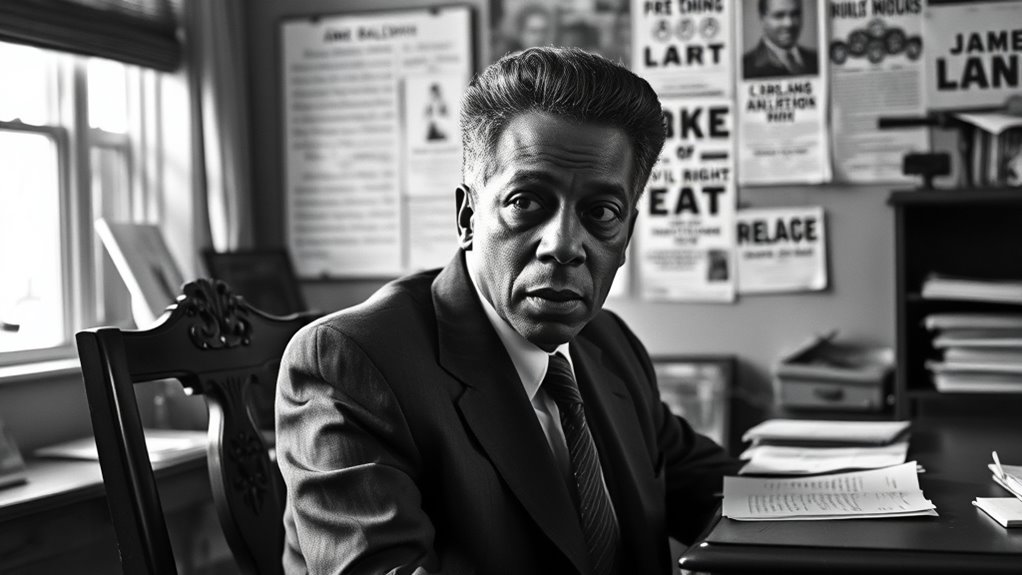
Have you ever wondered how an artist and writer can influence a social movement? Baldwin’s role in the Civil Rights Movement goes beyond words. You can see his impact through:
- Returning to the U.S. in 1957 amid debates over segregation, actively engaging with key leaders like Martin Luther King Jr.
- Participating in major events such as the 1963 March on Washington and Selma marches, lending his voice to the cause.
- Using his essays like *The Fire Next Time* to expose racial injustices and inspire empathy nationwide.
- Joining organizations like CORE and SNCC, connecting his literary activism with on-the-ground efforts.
- Leveraging predictive modeling and data analysis to understand and address the social issues faced by marginalized communities, thereby amplifying his advocacy.
His speeches, writings, and presence made him a crucial bridge between intellectual critique and grassroots activism, shaping the movement’s moral and cultural landscape.
Journalism and Social Critique
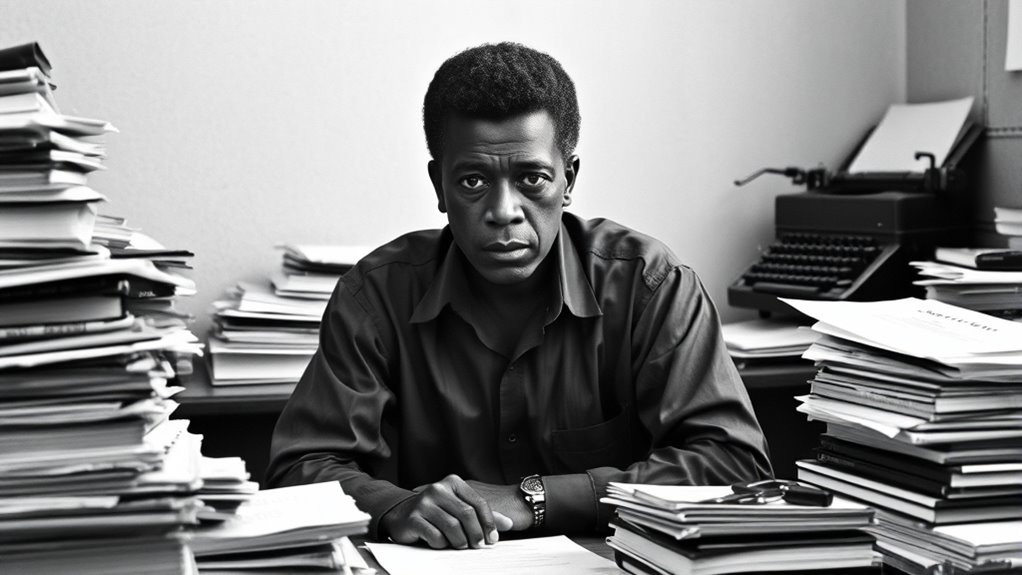
James Baldwin’s influence extended beyond the streets and marches into the sphere of journalism and social critique, shaping public opinion through his sharp, insightful writing. His first published work was a 1947 review of Maxim Gorky in *The Nation*, marking the start of a prolific career. Baldwin contributed essays to *Harper’s*, *Partisan Review*, and *The New Yorker*, tackling themes like racism, identity, and social inequality. He also published in *Commentary* and other national outlets. His work critically examined racial injustice in both the North and South, exploring human identity, sexuality, religion, poverty, and violence. Through essays like *The Fire Next Time* and *Notes of a Native Son*, Baldwin employed autobiographical elements and emotional depth, influencing social discourse and inspiring future activism. His essays were recognized for their *poignant clarity* and ability to challenge readers’ perceptions, making him a leading voice in American social critique. Additionally, Baldwin’s writings often incorporated literary techniques that amplified their emotional impact and persuasive power.
Relationships With Civil Rights Leaders
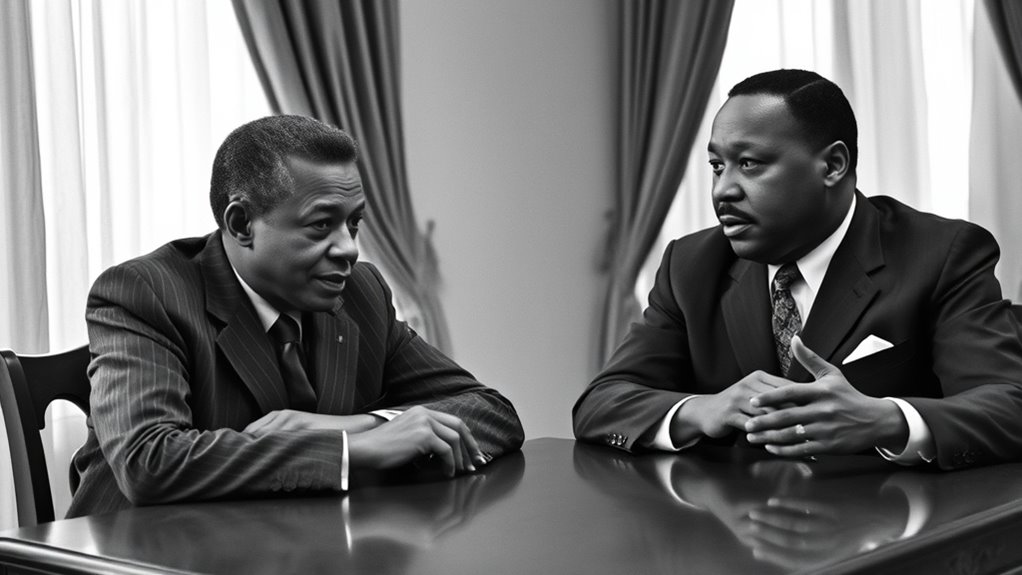
How did Baldwin navigate complex relationships with civil rights leaders, balancing admiration with critique? You see, Baldwin respected their courage but often questioned their methods. He admired Martin Luther King Jr.’s oratory and impact, profiling him in *Harper’s*, yet critiqued their differing approaches. His close friendship with Bayard Rustin showed solidarity, despite shared struggles with homophobia and exclusion from leadership. Baldwin’s bond with Medgar Evers highlighted his respect for grassroots activism, mourning his tragic death deeply. His complex relationship with Malcolm X reflected mutual respect amid ideological differences, both pushing for racial justice in their ways. Additionally, Baldwin’s ability to maintain empathy and open dialogue with diverse figures in the movement exemplifies his nuanced approach to leadership and advocacy. Baldwin’s connections reveal a nuanced web of support, critique, and shared goals, shaping his role in the movement.
Lasting Impact and Cultural Legacy
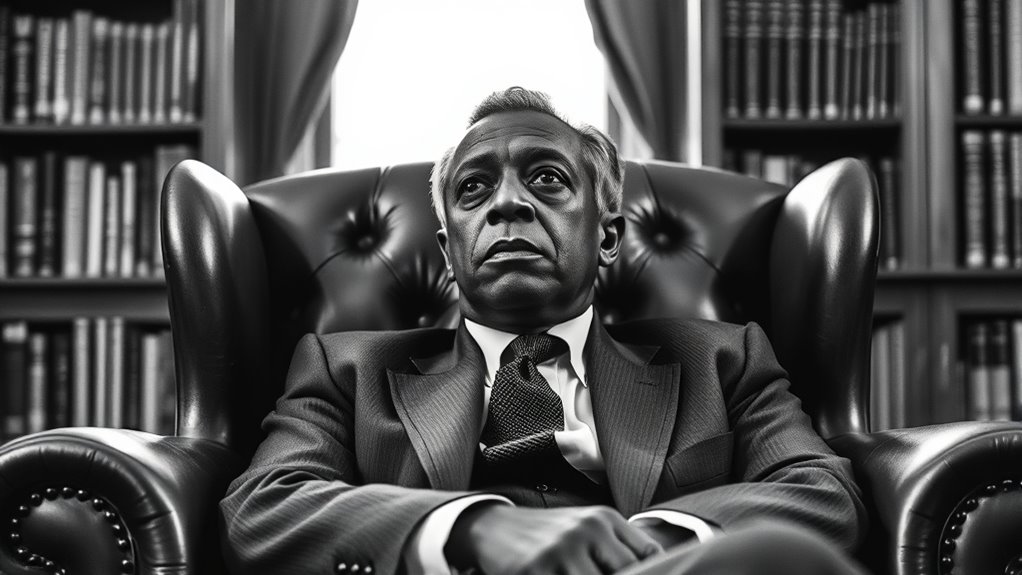
Baldwin’s relationships with civil rights leaders helped shape a legacy that extends far beyond his lifetime. His work revolutionized American literature by blending personal stories with social critique, inspiring writers like Toni Morrison and Ta-Nehisi Coates. His novels and essays are still central to academic curricula worldwide, highlighting their lasting importance. Baldwin’s writings challenged racism and systemic injustice, especially through works like *The Fire Next Time*, which urged social responsibility. He humanized Black experiences, portraying complex realities that defy stereotypes, and emphasized intersectionality across race, sexuality, and class. His influence extends into social movements, with themes from his work often cited by activists today. His speeches and public appearances further amplified his messages and connected him with a broader audience. Celebrated globally, Baldwin’s voice continues to resonate, inspiring ongoing conversations about identity, justice, and acceptance decades after his death. His ability to bridge personal narrative and social critique exemplifies his innovative approach to literature and activism.
Baldwin’s Continued Relevance Today

His work remains profoundly relevant today because it offers essential intersectional perspectives that address both racial and LGBTQ+ discrimination. Baldwin’s insights help you understand ongoing struggles faced by marginalized communities. His advocacy for love and empathy continues to inspire social justice movements. To see his relevance clearly: 1. His critique challenges mainstream narratives, revealing complexities around race, gender, and sexuality. 2. His historical context helps you connect past injustices with current systemic issues. 3. His forward-thinking philosophy encourages learning from history to foster future progress. 4. His advocacy for intersectional justice motivates contemporary activists to push for inclusive change. His emphasis on the interconnectedness of social issues highlights the importance of recognizing multiple facets of identity in the fight for equality. Additionally, Baldwin’s exploration of social justice frameworks provides valuable insights into addressing systemic inequalities today.
Frequently Asked Questions
How Did Baldwin’S Childhood Influence His Views on Race and Religion?
Your childhood deeply influences how you see race and religion. Growing up in Harlem, you face poverty, racial tensions, and a strict religious environment from your stepfather, which creates inner conflict. Witnessing prejudice and experiencing family struggles shape your understanding of racial injustice. These experiences make you question religious authority and develop a critical view of race relations, fueling your desire to challenge societal norms through your writing and activism.
What Specific Events Inspired Baldwin’S Most Famous Essays and Novels?
You might be surprised to learn that Baldwin’s most famous essays and novels were sparked by powerful moments of racial violence and injustice he witnessed firsthand. Events like police brutality in Birmingham, Dorothy Counts facing mobs, and marches like Selma deeply moved him. These coincidences of personal encounters and historic struggles fueled his writing, inspiring works like *The Fire Next Time* and *Another Country* to challenge America’s racial divide.
How Did Baldwin’S Sexuality Impact His Writing and Activism?
Your question explores how Baldwin’s sexuality shaped his work and activism. You see that his refusal to label himself allowed him to explore love and identity beyond societal norms, enriching his stories and essays. His openness about being gay, combined with his race, gave him a unique perspective that challenged norms, inspired others, and highlighted intersections of oppression. This authenticity made his activism more powerful and his writing deeply human.
In What Ways Did Baldwin Challenge Other Civil Rights Leaders’ Approaches?
You might think civil rights leaders all shared the same approach, but Baldwin challenges that idea. He questions reliance on nonviolence or separatism, pushing for a broader strategy that includes cultural and psychological change. Baldwin believes true progress requires confronting internalized racism and embracing radical love. His critique urges leaders to look beyond legal reforms and focus on personal transformation, making activism more holistic and deeply rooted in emotional and spiritual growth.
How Is Baldwin’S Work Relevant to Today’S Social Justice Movements?
Your current question explores how Baldwin’s work remains relevant today. You see, his honest critique of systemic racism, focus on intersectionality, and belief in love as a force for change continue to inspire modern social justice movements. Baldwin’s stories challenge stereotypes, promote empathy, and highlight issues like mass incarceration and identity. His emphasis on compassion and understanding guides activists seeking inclusive, transformative change, making his legacy essential to ongoing struggles for equality.
Conclusion
As you reflect on Baldwin’s life, remember that knowledge is power, and understanding sparks change. His courage in confronting injustice reminds us that the truth may be uncomfortable, but it’s necessary for growth. Baldwin’s words continue to inspire, urging you to speak out and stand up for what’s right. Embrace his legacy, for as the saying goes, “The only thing necessary for the triumph of evil is for good men to do nothing.”

